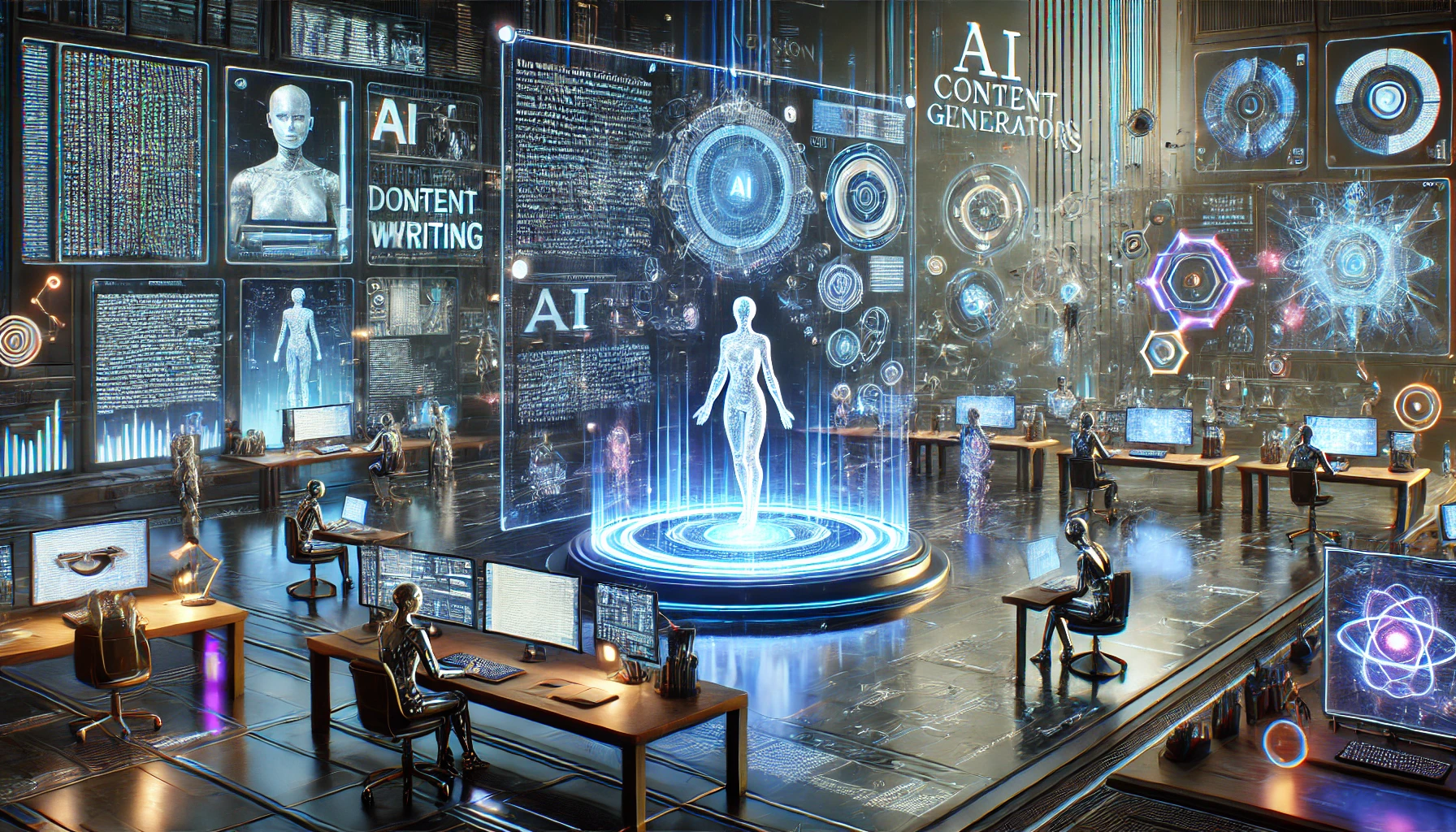
Introduction
Creating engaging and high-quality content is more important than ever in today’s fast-paced digital world. However, consistently producing such content can be a daunting and time-consuming task. AI content generators have emerged as powerful tools that streamline the writing process, making it faster, more efficient, and accessible to all, from businesses to individual creators. These advanced tools leverage artificial intelligence to automate written content creation, revolutionizing how we produce text in various fields, including marketing, blogging, and social media. This article delves into how AI content generators work, their advantages, popular tools on the market, and how to incorporate them into your content strategy best.
What Are AI Content Generators?
AI content generators are advanced software solutions that use technologies like machine learning and natural language processing (NLP) to create written content based on user input. These tools can generate a wide array of text, from articles and blog posts to product descriptions and marketing copy. By analyzing massive datasets of existing content, AI content generators learn how to mimic human writing styles, allowing them to produce coherent and engaging text that fits various needs.
How AI Content Generators Work
- Natural Language Processing (NLP): NLP is the core technology behind AI content generators, enabling them to understand and generate human-like language. By analyzing language structure, semantics, and context, NLP allows these tools to create text that feels natural and relevant.
- Machine Learning Models: Most AI content generators are powered by sophisticated models like GPT-4, which are trained on vast amounts of text data, including books, articles, and web pages. These models learn patterns, sentence structures, and the nuances of human writing, allowing them to generate new content that is both engaging and accurate.
- Input-Based Content Creation: Users provide prompts, keywords, or specific instructions to the AI, guiding it in generating content that aligns with their needs. The AI processes this input and produces text that matches the style, tone, and format specified by the user.
- Continuous Learning: AI content generators are designed to improve over time, learning from feedback and interactions. This continuous adaptation helps them refine their output, ensuring the generated content remains relevant and up-to-date with evolving language trends.
Popular AI Content Generators
Several AI content generators have gained traction for their ease of use, versatility, and effectiveness. Below are some of the leading tools currently available:
- Jasper AI: Known for its versatility, Jasper AI excels in creating content for blogs, social media, and marketing materials. Its templates and customization options make it a top choice for businesses and content creators looking to boost productivity.
- Copy.ai: Copy.ai is celebrated for its ability to craft engaging marketing copy, including product descriptions and social media posts. Its intuitive platform and wide range of templates make it an excellent tool for those seeking to streamline their content creation process.
- Writesonic: Writesonic offers tools for generating SEO-optimized content, from blog posts to landing pages. It uses AI to ensure that the text is engaging and effective in reaching the desired audience through search engines.
- Rytr: Rytr is a versatile AI writing assistant that supports multiple languages and writing tones, helping users generate content that matches their brand voice. It’s ideal for crafting everything from articles to social media updates.
- Copysmith: Specializing in e-commerce and marketing content, Copysmith helps businesses create compelling ad copy, product descriptions, and other sales-oriented text. Its AI-driven approach ensures the copy is persuasive and aligned with marketing goals.
Applications of AI Content Generators
AI content generators are revolutionizing content creation across various industries, enhancing productivity and creativity. Here are some key applications:
- Blog Writing and Article Creation
- AI content generators can quickly produce well-structured and SEO-friendly blog posts, making them invaluable tools for bloggers and digital marketers. They help generate outlines, draft content, and suggest relevant keywords, significantly speeding up the writing process.
- Example: Jasper AI can generate comprehensive blog posts based on simple prompts, allowing writers to focus on refining and adding personal touches to the content.
- Social Media Management
- Maintaining an engaging social media presence requires consistent and creative content. AI content generators automate the creation of posts, captions, and even hashtags, helping brands stay active and relevant on social platforms.
- Example: Copy.ai is often used by social media managers to draft eye-catching posts and captions that align with current trends and resonate with followers.
- Email Marketing
- AI content generators simplify the process of writing persuasive and personalized email campaigns. They assist in drafting subject lines, email bodies, and calls to action, helping improve open rates and engagement.
- Example: Writesonic aids marketers in creating email sequences that nurture leads and guide prospects through the sales funnel, enhancing overall campaign performance.
- E-commerce Product Descriptions
- Writing unique descriptions can be labor-intensive for e-commerce businesses with extensive product catalogs. AI content generators automate this task, crafting descriptions that effectively highlight product features and benefits.
- Example: Rytr generates SEO-friendly product descriptions that improve search visibility and enhance the shopping experience for customers.
- Creative Writing and Ideation
- AI content generators are not just for informational text; they also serve as a source of creative inspiration. From brainstorming plot ideas to drafting poetry, these tools provide new perspectives and help writers overcome creative blocks.
- Example: Authors use Jasper AI to explore character developments, plot twists, and dialogue options, expanding their creative boundaries.
- Technical Documentation
- Creating clear and concise technical documentation can be challenging. AI content generators assist in drafting user manuals, guides, and other technical documents, making complex information more accessible.
- Example: Copysmith is used by tech companies to generate user-friendly guides that help customers understand their products better.
Benefits of AI Content Generators
- Time-Saving: AI content generators drastically reduce the time required to create content. Automating the initial draft allows creators to focus on editing and enhancing the text rather than starting from scratch.
- Cost-Effective: Hiring professional writers for every content need can be expensive. AI content generators offer a more affordable alternative, enabling businesses to produce high-quality content without incurring high costs.
- Consistency and Scalability: AI tools ensure that content remains consistent in tone and style, making it easier to maintain a cohesive brand voice. They also scale effortlessly, meeting growing content demands as businesses expand.
- SEO Optimization: AI content generators incorporate SEO strategies, helping users create optimized content for search engines. This leads to improved rankings and increased organic traffic.
- Boosts Creativity: AI content generators provide fresh ideas and different perspectives, helping writers think outside the box. This creative boost can lead to more engaging and innovative content.
- Data-Driven Personalization: Advanced AI tools can tailor content to specific audience segments, enhancing the effectiveness of marketing messages and improving engagement.
Challenges and Considerations
- Quality Control: While AI can produce high-quality content, it’s not infallible. Reviewing and editing AI-generated content is crucial to ensure it meets the desired standards and accurately conveys the intended message.
- Risk of Plagiarism: AI-generated content may unintentionally resemble existing text. It’s important to use plagiarism checkers to confirm the originality of the content before publication.
- Maintaining Authenticity: AI-generated text can sometimes feel impersonal. Adding personal anecdotes, insights, and a unique voice can make the content more relatable and engaging.
- Dependence on Input Quality: The quality of AI-generated content depends on the prompts. Clear, detailed instructions are essential for the AI to produce relevant and accurate text.
- Ethical Considerations: The growing use of AI in content creation raises ethical concerns about transparency and disclosure. It’s important to be upfront about AI’s role in content generation to maintain trust with readers.
Tips for Effectively Using AI Content Generators
- Define Clear Objectives: Clearly outline what you want the content to achieve. Specific prompts will guide the AI in generating more targeted and relevant content.
- Edit and Add Personal Touches: Always review AI-generated content to ensure it aligns with your brand’s voice. Editing lets you personalize the text, making it more authentic and engaging.
- Use AI as a Tool, Not a Replacement: AI content generators are best used as assistants. Combine their efficiency with your creativity to produce content that is both effective and unique.
- Monitor and Analyze Performance: Track how AI-generated content performs using analytics tools. Use insights to refine future content and improve overall strategy.
- Stay Updated on AI Trends: AI tools are constantly evolving. Keep up with new features and advancements to maximize these tools’ benefits.
Conclusion
AI content generators are revolutionizing how we create content, offering unprecedented speed, efficiency, and scalability. By automating the writing process, they empower businesses and individuals to produce high-quality content that engages audiences and drives results. However, for the best outcomes, combining AI-generated content with human creativity and oversight is essential, ensuring that the text remains authentic, relevant, and aligned with your brand’s voice.


Could you clarify which article or content you’re referring to? This way, I can provide more specific details and clear up any doubts!